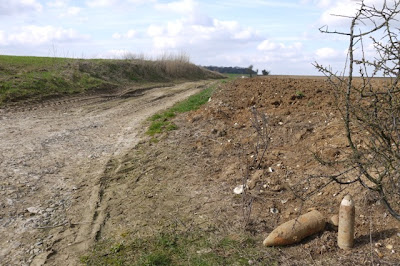Back to the March trip to the Somme - seems years ago now that we were enjoying temperatures of 70 deg!!
As usual the so called 'Iron Harvest' was in evidence so a few pictures of unexploded ordnance we came across.
Above shows British 4" or 6" shell (cannot remember which) and Stokes Mortar round
Above are two shots of shells looking towards the infamous High Wood - bottom photo is looking down Wood Lane.
Above three - top photo shows a couple of shells and a so called 'Toffee Apple' mortar round - the British 2" mortar which fired a 60lb bomb in the shape of a steel ball approx 9 inches diameter. Middle photo shows a dump of 'toffee apples' during the War while bottom photo shows the mortar itself.
Above: A mixture of Stokes 3" mortar rounds and shells. Note the German 'Butchers' bayonet. Bottom photo shows the British Stokes 3" mortar.








Comments
Post a Comment